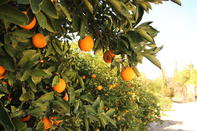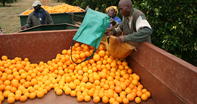Oranges Galore
Situated along the upper reaches of the Olifants River Valley, Citrusdal is bounded in the west by the Olifants River mountains and by the Cederberg range to the east.

The area was first explored in 1660 by the Dutch soldier Jan Danckaert and farmers began settling in the fertile valley in 1725. Citrusdal is the centre of South Africa’s third-largest citrus-producing area and accounts for about 14 per cent of the total crop. It is especially noted for its navel and Valencia oranges, grown by about 200 farmers in the area. The valley also has a tradition of winemaking going back more than two centuries and produces a wide range of red and white wines, as well as dessert wines and wine for brandy.
The Early Citrus Industry
How citrus arrived on the shores of Africa from the tropical rainforests of Southern China and the Malay Archipelago and ended up on the Olifants River Valley is a historical tale. Arab traders from long ago carried sour oranges, limes and lemons from their homes in Asia and planted them throughout the Middle East, along the north coast of Africa, Spain and down the east coast of Africa as far south as Zimbabwe.
It is said that the first European settlers were surprised to find lemon trees growing on the banks of the Mazowe River. The Crusaders introduced the apricot, sour orange, lime and lemon to the more northerly parts of Europe. The sweet orange only appeared much later, sometime in the 15th Century.
The story goes that it was Vasco Da Gamma who after rounding the Cape of Good Hope sailed to Mombassa in 1498 and was received by the Arab ruler there, who plied him with produce from the palace, including ‘citrons, lemons and sweet oranges’. It is thought that Da Gamma returned to Portugal with this fruit bounty, hence Portugal’s claim of growing the first sweet oranges in Europe. Apparently, the first sweet orange of the western world grew in Lisbon, in the garden of Count St Laurent.
The arrival of the sweet orange to the shores of Southern Africa is more clearly recorded. On 11 June 1654, the ship Tulp brought the first sweet orange trees to Cape Town from St Helena where the Portuguese had planted them to aid sick sailors. The first trees in South Africa were planted in the Company’s Garden. On the 26th July 1661, the first fruits were picked by Jan Van Riebeeck and were recorded as being “very good”.
From Seedlings to Orchards
Other varieties of sweet oranges were imported from India to South Africa. By the time that the St Helena oranges bore their first fruit, Jan Van Riebeeck had 1162 citrus fruit trees growing in his garden, making it the first South African orchard.
It contained an interesting assortment of seedling oranges, lemons and the Citrus maxima, known as bombolmoes in Tamil, pampelmoes in Dutch, and known to the British as the pummelo or Shaddock, after Captain Shaddock who introduced it to the West Indies where its bud mutation, the grapefruit, first developed.
From this pioneer orchard, the citrus trees were dispersed over the expanding farm settlements of the Cape. In the late 18th century when the Olifants River Valley was portioned out to settlers, the first citrus family reached the Hexrivier when the farm was granted to C J Mouton. It is now a historical monument and the old tree still bears a palatable and juicy fruit after more than 200 years of changing seasons!
Washington Navel

The backbone of orange production is the Washington Navel. This tasty fruit originated in Bahia, Brazil in the early 19th century, where it was a possible mutation from the Selecta orange, that was introduced by the Portuguese. In 1869, Reverend F I Schneider, the first Presbyterian missionary in Bahia, sent a report about the orange to the United States Commissioner of Agriculture.
In reply, the missionary was asked to send a few trees to Washington for testing, which he did a year later. This has proved to be a momentous find in the history of orange growing. In Washington, the Department of Agriculture propagated the trees. In 1873 the first budded specimens were sent to various parts of the United States to see how they would grow.
Two of the trees were sent to Mrs L C Tibbets, in California, who planted them in her yard. There they flourished, and from these two trees arose the entire naval orange industry, not only of the United States but also of most of the world. One of the parent trees is still alive. Its seedless offspring, all grown from cuttings, must run into many millions.
Think of that next time you cut a juicy navel orange! In 1903, the Washington Navel was introduced to South Africa, by Harry Pickstone, a nursery-man, who also introduced to this country the second great commercial variety, the Valencia Late. This orange came into being at almost the same time as the Washington Navel.
In 1876 an assorted, unlabelled package of orange trees was shipped by British nurseryman, Thomas Rivers, to the Californian grower, A Chapman. Chapman cultivated the trees but only one proved of any value. This single tree, however, was worth a fortune, for its fruit, although it bore seeds, ripened later in the season than the Washington Navel. Chapman named his orange tree the Valencia Late and introduced it for massive commercial growing across the globe.
South African Oranges
As in America, the two varieties of orange, Washington orange and Valencia Late, contribute the great bulk of the tons of citrus fruit grown in South Africa each year. Both varieties do exceptionally well in South Africa. On the intensely competitive world markets, the fruit is highly regarded.
Of the main orange-growing areas of South Africa, the Olifants River valley is the smallest producer (about 100 000 tons a year) but its product is of a supreme standard. The Olifants River Valley lies in a winter rainfall area with low humidity.
Hot summers and frostless winters make a good home for the citrus family. Added to that good soil chemistry, combine to naturally produce a fruit with a thickish skin, that is palatable with a sugar balance that is not too tart or insipid. It is generally considered that the Olifants River Valley is almost ideal in flavour and tissue.
 Citrus fruits are characterised by their sharp flavour and some citrus types, such as lemons and limes, are sour or tart to the taste, while...
Citrus fruits are characterised by their sharp flavour and some citrus types, such as lemons and limes, are sour or tart to the taste, while...